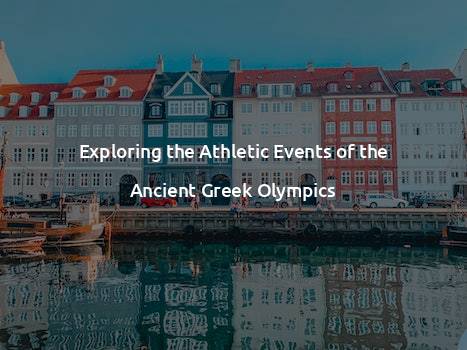Exploring the Athletic Events of the Ancient Greek Olympics
The Ancient Greek Olympics: A Glimpse into the Past
The Ancient Greek Olympics were much more than just a sporting event. They were a celebration of athleticism, culture, and unity. Held every four years in the city of Olympia, these games brought together athletes from all over Greece to compete in a variety of athletic events. Let’s take a closer look at some of the most prominent athletic events of the Ancient Greek Olympics.
The Foot Races: A Test of Speed
Foot races were the cornerstone of the Ancient Greek Olympics. These races were performed in various distances, with the stadion race being the oldest and most prestigious. The stadion race was a sprint of about 200 meters, and the winner was awarded a wreath made of olive leaves, a symbol of victory and honor.
Another popular foot race was the diaulos, which was double the length of the stadion race. The athletes would run two lengths of the stadium track, totaling approximately 400 meters. The longest foot race was the dolichos, a grueling long-distance race that tested the endurance of the athletes. It covered a distance of around 1500 meters.
Wrestling: The Art of Combat
Wrestling was considered an essential skill for any Ancient Greek man, and it played a significant role in the Olympic Games. This hand-to-hand combat sport showcased the strength, agility, and tactics of the wrestlers. The objective was to force the opponent to touch the ground with their back, shoulder, or hip. The wrestlers used a combination of techniques, such as holds, throws, and tripping, to gain the upper hand.
The Ancient Greek Olympics had no weight classes, meaning that larger and smaller athletes would often compete against each other. These matches were fierce displays of athleticism and strategy, as the wrestlers grappled to gain superiority over their opponents.
The Pentathlon: The Ultimate Challenge
The pentathlon was a five-event competition that assessed an athlete’s overall capabilities. It consisted of running, long jump, discus throw, javelin throw, and wrestling. The winner of the pentathlon was considered the most versatile and well-rounded athlete of the games. The pentathlon emphasized a combination of speed, strength, agility, and technique, making it one of the most challenging and highly regarded events of the Ancient Greek Olympics.
Chariot Racing: The Thrill of Speed
Chariot racing was a spectator favorite at the Ancient Greek Olympics. It was an exhilarating event that combined athleticism and skill with sheer speed. The charioteers, usually slaves or professionals, drove their horses through the racecourse, maneuvering sharp turns and racing towards the finish line. The races were dangerous, with collisions and falls common occurrences.
Chariot racing was divided into different categories, depending on the number of horses pulling the chariot. The events included single-horse chariot races, two-horse chariot races, and four-horse chariot races. The chariots were pulled by powerful horses, and the skill of the charioteer was crucial in maintaining control and winning the race.
TLDR;
The Ancient Greek Olympics featured a variety of athletic events that celebrated strength, skill, and speed. The foot races tested sprinting and endurance, with the stadion race being the most prestigious. Wrestling showcased hand-to-hand combat skills and tactics. The pentathlon challenged athletes in five different disciplines to determine the most well-rounded competitor. Chariot racing combined athleticism and speed, thrilling spectators with dangerous and exciting races. These events are a testament to the rich athletic tradition of the Ancient Greek Olympics and continue to inspire and captivate us today.







